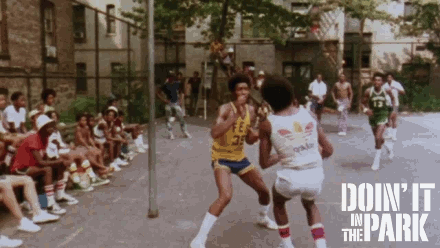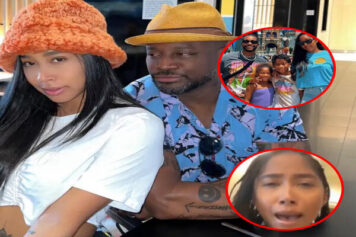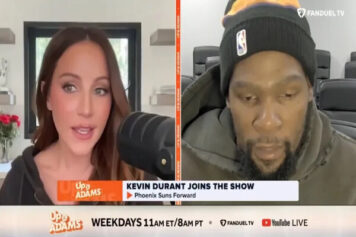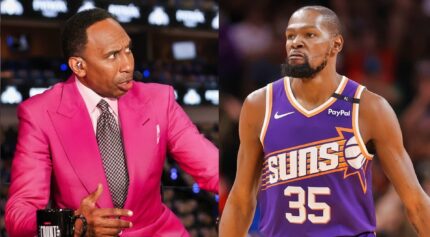Two years ago, the NBA’s usual five month layoff slipped into an eternal slumber. While millionaires and billionaires tussled over revenue sharing and max contracts, there was a renaissance taking place away from the negotiating table involving The League’s locked out stars. It rekindled a long-forgotten love affair with playground hoops. While the season faded to black, NBA stars went back to the blacktop.
Kobe Bryant, James Harden, Carmelo Anthony and others reveled in the summer of streetball love, but Kevin Durant was the unofficial lead NBA ambassador as the high-def images of him going ham at Rucker for 66 points, or leading the Goodman League’s best against EBC All-Stars went viral. It was a brief return to the grassroots of blacktop hoops. Since then, Durant’s returned to the playgrounds every summer catapulting shots at rates that would be unconscionable on an NBA floor for even the NBA’s most gifted scorer. Where else could the NBA’s perennial scoring champ take 62 shots? However, his fellow stars haven’t re-joined him since.
That summer, there were as many NBA megastars doing work on the blacktop as there were heading abroad. Both were aberrations.
The culture has changed so drastically that Pee Wee Kirkland, New York City’s streetball answer to Josh Gibson once turned down a contract from the Chicago Bulls because he figured he could make more money in the streets. Kirkland called New York City pickup hoops the essence of basketball, adding, “I don't know if you can be a basketball player without experiencing pickup basketball."

Jason Woullard: Streetball Hoops: The Essence of Basketball– A look at streetball's venues, history and great ballers of yesteryear.
Before AO, Hot Sauce and Skip To My Lou barnstormed with And1, the Harlem Rens toured with Clarence “Fats” Jenkins, James “Pappy” Ricks and Frank “Strangler” Forbes. However, the Rens were disbanded in 1949 after integrating into the NBL, which merged with the BAA — the primordial goo for the NBA.
Once African-American players began trickling into the NBA by the early 1950’s, they introduced their acrobatic moves, showmanship and the flair ingrained in them on the concrete jungle courts to the NBA.
For the next half century, black players would frequently return to playground blacktops during their offseason downtime.
In a piece published on Grantland last year, the summer of ‘57’s events – when Wilt Chamberlain and Elgin Baylor went at it on D.C. courts – were recounted in detail and paint a very different picture than the modern streetball scene.
The city's top young black ballplayers played alongside the headliners, making for an ungodly assemblage of future NBA first-round picks, NCAA tournament MVPs, and Hall of Famers. Flash mobs created entirely via analog social media appeared wherever Chamberlain and Baylor played.
"It was people hanging on the fences, on the rooftops, everybody there to watch Elgin and Wilt," says Ernie Dunston, who in 1957 was a sophomore at Spingarn High School, and who would later follow fellow Spingarn alum Baylor to Seattle University.
Four decades later, 1992’s White Men Can’t Jump, ‘94's Above The Rim and the launch of SLAM Magazine took the gritty streetball culture mainstream. The ensuing explosion of the AND1 Tour at the turn of the century put streetball front and center. At the peak of And1’s mixtape relevance, Nike was the only shoe conglomerate that had more athlete endorsers in the NBA.
That was then. To get a perspective on streetball’s vanishing relationship with NBA stars, in 2007, the NBA cancelled its NBA Street video game series and the rundown of And1's NBA’s shoe endorsers was down to Lance Stephenson as of 2013.
Hoops’ Underground Battles

In an ESPN.com column published in June, TSL member Scoop Jackson lamented AAU Deebo’ing streetball’s future legends in the making by AAU summer tourneys. However, the simultaneous retreat of NBA megastars and collegiate stars away from outdoor summer leagues has been just as discouraging.
Wilt Chamberlain, Elgin Baylor, Allen Iverson, Dr. J and Rafer Alson are a few of the most prominent NBA pro-playground interlopers of yesteryear. The most popular NBA streetballer in today’s game is probably Uncle Drew.
Occasionally, A-List NBA stars still descend down from their hollowed hardwood arenas to grace the blacktop with their presence, but the massive summer migration of pros to summer leagues has sputtered in recent years, as have the success of some summer leagues.
The EBC, Goodman and Drew – the holy hoops trinity of summer leagues – remain the main draw for NBA athletes, but smaller tournaments are suffering. In 2009, the Kingdome Classic in Harlem nearly closed down shop after 25 years due to struggles.
On streetball’s most revered outdoor courts, it’s an opportunity to witness NBA deities putting their reps on the line against streetball’s finest. Forty years ago, streetball was the Wild West within a concrete jungle. Instead of cowboys and Indians gun slinging on the open range, pro stars and the “best who never made it to the League” went mano-y-mano trading shots and crossovers on the asphalt blacktop scene.
Tiny Archibald’s battles with Pee Wee Kirkland and Dr. J.’s tilts against Joe “The Destroyer” Hammond were epicenters of the asphalt-hardwood wars in the ‘70s.
Most streetball legends including Cali’s Demetrius "Hook" Mitchell, Raymond Lewis or Chicago's Billy ‘The Kid’ Harris never make it out the streets. A few like James “Fly” Williams embark on brief forgettable collegiate or ABA careers, but their true legacy was forged on the word of mouth of spectators in the bleachers from Seattle’s “Battle at the Lake” or on Cali’s radiant Venice Beach. Their validation used to come in summer duels with NBA stars passing through looking for a run, but that rite of passage has withered up. There aren’t many more stories of Connie Hawkins spontaneously joining Kareem Abdul-Jabbar and Clinton Robinson in a five-on-five show.
“Fly” Williams once dropped 63 on his contemporary Moses Malone in the Dapper Don Classic and his battles with Dr. J were documented in Bobbito Garcia’s Doin’ It In The Park doc.
The last great Rucker battle in streetball-NBA lore occurred 14 years ago when Adrian Walton aka "Whole Lotta Game" burnished his rep in a legendary back-and-forth with Vince Carter. The “battles” feel more like sparring matches in contrast to the fervent world-beater runs of the past.
The Pro And College Systems Are Strangling The Streetball Product
On sweltering Thursday nights in Harlem, New Yorkers along with tourists from around the world flood the sidelines of the world renowned Rucker Park for the Entertainer’s Basketball Classic to experience the atmosphere and the world’s best streetballers going at it. In the past that meant regular appearances from the best players in the world.
When pressed on how much the game has changed in the three decades he’s run the EBC Invitational, founder Greg Marius bemoaned the paucity of great players from the collegiate and pro levels lacing up.
The acclaimed ‘97 documentary Soul In The Hole followed “Kenny’s Kings,” the juggernaut of a streetball squad running circles around competitors in a Brooklyn tournament during the summer of ‘93. “Kenny’s Kings” were led by streetball phenom slash one-time Sports Illustrated coverman Ed “Booger” Smith and the slick, two-time NCAA scoring champ, Charles Jones. When pressed on how much the game has changed in the three decades he’s run the more heralded EBC Invitational, founder Greg Marius bemoaned the paucity of great players from the pro and collegiate levels participating.
“It’s not as many great players as there used to be,” Marius sternly told The Shadow League. “In my days of watching guys play, it used to be like 12 All-Stars on each team. Now it’s like two or three.”
Marius faults the NCAA for the dwindling numbers of college stars playing in summer league tournament.
“You used to be able to play in as many summer leagues you wanted,” Marius told The Shadow League. “Now, it has to be a [NCAA] sanctioned tournament and you can only play in one.”
Back when the EBC was played at Mount Morris Park on 120th and Madison Avenue, Marius would stack his Disco 4 squad with guys like Pearl Washington from Syracuse, UNLV's Richie Adams and Arkansas' Richie Hutchinson. These days, NCAA bylaws might prevent Adams and Hutchinson from participating in the EBC.
“You limit the guys who are really from here being able to play. So there was a lot of talent because of the college player, but now there’s not much because of the fact that they’re always at their school.” Marius added.
NCAA bylaw 14.7.3.2 allows student-athletes to compete in a single NCAA-sanctioned summer league between June 15 and August 31. Geographic limitations mentioned within the bylaw also keeps student-athletes from competing more than 100 air miles from their student residence.
“Half the time when you’re waiting for a college kid to come home and play, he’s at school,” Marius told The Shadow League. “By the time he comes home there’s only a week or two left, so it‘s like what’s the purpose of playing? And they have tournaments in the areas where their schools are at.”
The EBC still has the allure and appeal to attract celeb coaches and even a few pros like Davis Lee and Tyreke Evans, but the type of star-studded runs that crowds were nearly privy in the summer of ‘03 are on the verge of extinction. The mile-long line to cram into Rucker to watch Jay-Z’s Team Sean Carter (led by Lamar Odom, Sebastian Telfair, Jamal Crawford, Eddy Curry) trade buckets with Fat Joe’s Terror Squad ( featuring Carmelo Anthony, Amar’e Stoudemire, Zach Randolph, Stephon Marbury, Rafer Alston and Al Harrington) for the 2003 EBC Championship Game looped around a couple blocks. The game was cancelled due to a 12-hour blackout across the city and the likes of it likely won’t be seen again.
On July 25, I swung through to check out the EBC Invitational for the first time. The threat of inclement weather moved the doubleheader indoors and just across the Harlem River in the Bronx to the NY Gauchos’ AAU gym. In the second game, Sundiata Gaines – the former UGA combo guard, whose jersey adorns the wall when you walk into the NY Gauchos gym – suited up for Team MMG, but wasn’t joined by any other prominent collegiate hoopers. His squad went head-to-head with Team Nas, led by Nick Young, the newest Laker addition who drove up from Philly just to take his first crack at a run with the Rucker talent.
Gaines actually brought his A-Game, but Young didn’t provide many highlights as Team Nas was eviscerated by 30.
Sixteen years ago, the decline in major talent showing up at major streetball tournaments had already become noticeable. While comparing the competition in the ‘97 EBC tournament to the ballers in his heyday, Joe “The Destroyer” Hammond, singled out the quality of talent. Hammond also told SI’s Rick Telander. “All the pros used to play here. Wilt, Tiny, Julius, Kareem. It changed when pros quit playing on concrete.”
NBA players have a financial incentive to limit their appearances on harsh asphalt courts. The stacks of cash to be made are mounted higher these days and the risk/reward ratio is skewed heavily against putting their money in peril. NBA millionaires wake up in cold sweats at the mere thought of getting eight-figure contracts voided.
It's vital for modern NBA players to negotiate a “Love of the Game” clause into their contracts to play ball without risking their seven, eight and nine-figure contracts. Money talks. So does patriotism. The four-year commitment to the Olympic program instituted after the 2004 Games will keep the NBA’s top young superstars even more preoccupied.
Besides, as more and more players begin using the AAU network to matriculate through the hoops, NBA pros become less familiar with the playground hoops scene as youngsters.
The world has changed since the summer of ‘57, the stakes are higher for NBA players and streetball has witnessed the effect of NBA players withdrawing from the playground hoops scene. There’s no telling if the future holds another possible renaissance in sight.



